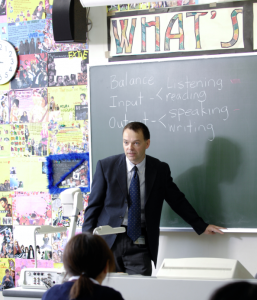 Three questions for large classes
Three questions for large classes
When I first started teaching large classes, one of my biggest challenges was to keep students speaking English during activities. I liked to have students work in pairs or groups so they’d have more chances to speak. I’d move around the classroom while they were working, so I could hear which language students had mastered and which language still needed practice. No matter how much I tried to enforce an “English Only” policy in class, I still heard students using a lot of Japanese. I wondered why my students didn’t want to use English in English class.
As my Japanese improved, I finally realized that sometimes, my students were simply trying to figure out what I wanted them to do: Do you understand what she wants? How do you say this in English? What did she say? I realized that in some cases my instructions were unclear, and in other cases activities actually required students to use language that they hadn’t yet learned.
I became more careful when preparing activities. I tried to do them myself to see what language would actually be needed. I kept instructions simple, and tried to repeat activity types so that they would be familiar. I began to model activities with the class before asking students do them.
Most importantly, I asked students three questions before every activity:
Do you understand the language?
Do you know what to do?
Is there any reason you need to speak Japanese?
It worked as a kind of contract between us. I promised to take time before an activity to explain and demonstrate so that students were not responsible for being my translators. They promised to do the activity in English. After that, whenever I did hear Japanese, I simply asked the questions again. Students generally laughed and switched back to English. I even heard students “being me” and asking each other the questions as a way to monitor Japanese use in class.
These were simple changes, but they made a huge difference. I made myself responsible for being clear and fair in my expectations. Students made themselves responsible for speaking English in class.






